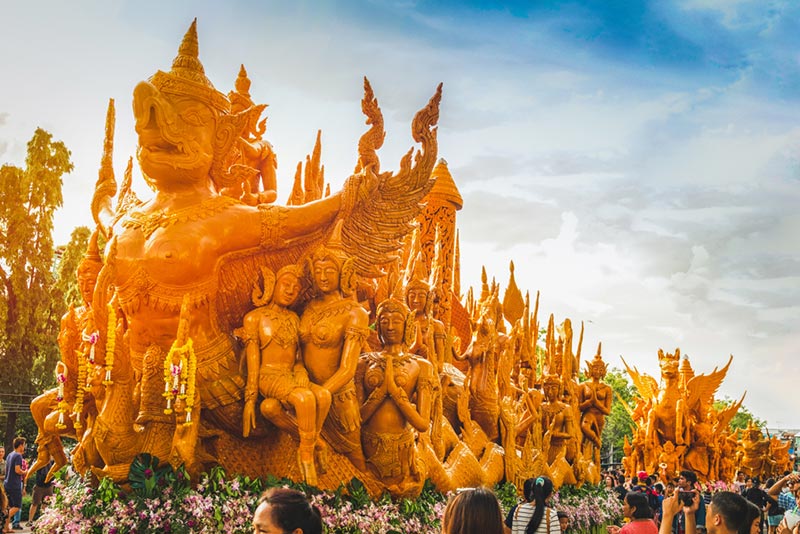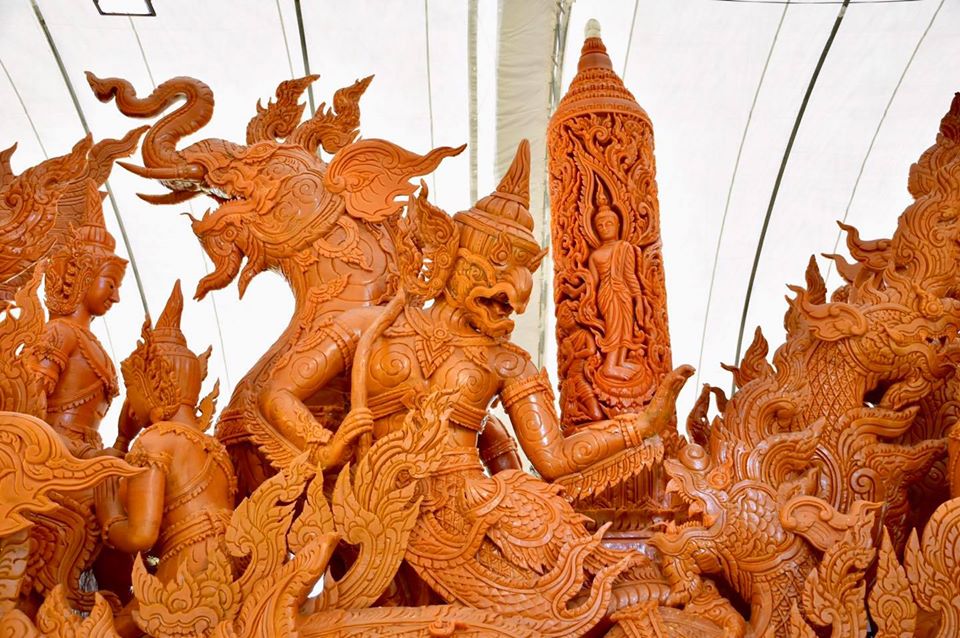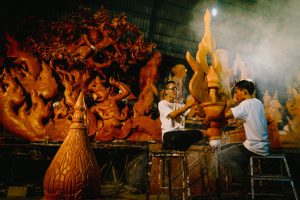Candle Festival – An Exquisite Sight of Ubon Ratchathani Province
 [cr.tuu sitt / Shutterstock.com]
[cr.tuu sitt / Shutterstock.com]
In 2016, at Wat Chai Mongkhon, a temple in the province of Ubon Ratchathani, an enormous Buddhist Lent candle sat on a large wagon parked under the shade of a nearby pavilion. A wooden scaffold lay on the side. Local monks, novices, and members of the community busied themselves with the preparation of a candle. Some were boiling down candle wax, while others were brushing the candle’s surface with coconut oil. On the scaffold, a senior craftsman was carving an elaborate pattern on the surface of the candle. Prakru Jitvisutyannakun, the abbot of the temple, paid close attention to the entire process.
Soon after, the streets of Thung Si Muang District, in the heart of the Ubon Rachathani Province, were teeming with people, especially in front of another temple, Wat Si Ubon Rattanaram, where the Candle Festival parade began. Grandstands lined both sides of the road. After the opening ceremony, the parade slowly moved along Upraj Road and Chayangkun Road. Various processions took part, each led by a community group. Ubon Ratchathani’s Candle Festival has always been held on a grand scale, and Wat Chai Mongkhon is a well-known name.
“Wat Chai Mongkhon has been creating candles for the Buddhist Lent Festival for over forty years without exception, as the tradition is very important for our province. This year, we’re using ‘Nakhon Tham’ (City of Virtue) as the main thematic inspiration of our work. It’s meant to display the unique identity of Ubon Ratchathani,” Prakru Jitvisutyannakun graciously explained.
Apart from the community that gathered at Wat Chai Mongkhon, other communities in Ubon Ratchathani, such as those of Wat Jang, Wat Si Pradu, Wat Burapha, Wat Si Ubon Rattanaram, and Wat Thung Si Muang, also made their own Buddhist Lent candles.
 [cr. i-san.tourismthailand.org]
[cr. i-san.tourismthailand.org]
The Buddhist Lent is a time when monks must strictly stay in temples for three months. At the start of the lent season, in what is known by northeastern people as “Merit of the Eighth Month,” people will gather candles and essential supplies, such as food and clothing, and offer them to monks for them to be able to carry out their duties, particularly religious studies, with minimal difficulty during the season.
In the past, the Candle Festival of Ubon Ratchathani, normally held around July, was not as large as it is today. People would merely tie candles into bundles and provide them to the temples in their communities. The candles were either put in an ox-drawn cart or a wagon pulled by men, accompanied by a musical parade of drums, gongs, clappers, and folk dance.
As time passed, candles became increasingly larger and more intricate, generally rendered from the core teachings and legends of Buddhism, with complex designs based on the gods and angels or mythical animals of Himmapan Forest. These days, making an immense and extravagant candle often takes no less than a month. The process begins with design, then moves to the construction of the candle’s interior (using plaster or cement), the construction of wax around the interior, and finally the time-consuming carving, not to the mention the float, onto which the candle would in the end be placed.
A number of performances were also added to the parade, mostly traditional dance and music processions (such as fonrum, a folk dance) performed by local artists, often featuring sounds from northeastern musical instruments such as the phin (mandolin), the khaen (mouth organ), the ponglang (xylophone).
While carving is the traditional candle-decorating technique—developed by Kummha Sangngam, a Thai National Artist, in 1958—with time arose new techniques, including printing. In printing, the artisan melts candle wax into liquid and then pours it into a mold before pasting the product from the mold onto the surface of the candle to create a design. These days, many communities and organizations of Ubon Ratchatani send candles to the festival, some only for display and others for carving-technique competitions and printing-technique competitions.
After evolving from a small local event to a major event supported by both the government and the private sector, the Candle Festival of Ubon Ratchatani was officially recognized as a national cultural festival in 1976.

[cr.PLUEMSCAPE / Shutterstock.com]
Prakru Jitvisutyannakun continued, “We start the process of candle-making by discussing with people in the community what kind of work they want to make, with what sort of theme or idea. We bring the result of the discussion over to the artisans, so that they can draw out the design. Usually, we create a certain story or theme by incorporating various interesting characters from tales and folklores. This process allows the community to be part of the work, giving them a sense of ownership. The Candle Festival is not the same as other events held by the government. Those often have the sole purpose of gathering people to participate, but this is something that was born out of the collective feelings and ideas of what the community wants to display.”
In 2016, the Buddhist Lent candle that Wat Chai Mongkhon’s community made was a towering construction, 2.8 meters in width, 16.5 meters in length, and 4.5 meters in height, embellished with elaborate carving. The top of the candle was adorned with lotus patterns, while the trunk was engraved with the kranok pattern — one of the quintessential motifs in Thai design — lined over a floral pattern known as “Dok Puttan”. An image of the enlightened Buddha crowned the candle. The candle’s base was carved into the shape of a lotus placed over a kinnari, the mythical creature of Himmapan Forest. The front of the wagon displayed wax statues of figures who represented “Nakhon Tham” —famous Buddhist masters, including Mun Bhuridatta, Ajahn Chah, and Phra Ubaleekunuparamajarn (also known as Jun Sirijto).
A year earlier, the Candle Festival featured a 40-meter-long Buddhist Lent candle wagon, said to be the longest candle wagon in the world. The candle displayed the story of the Buddha, from birth to enlightenment and his last days (Parinirvana).
Adapted From
- Kangwal, Chakrapandh [กังวาฬ, จักรพันธุ์] “[วิจิตรตระกาลตา แห่เทียนพรรษาอุลราชธานี].” Watthanatham Journal: Department of Cultural Promotion, yr. 55, no. 4, October – December. 2016, pp. 50 – 57. Retrieved April 1, 2021. Link
October 11, 2021


